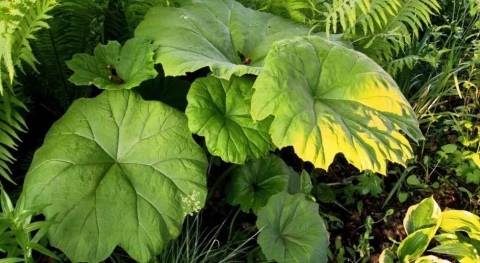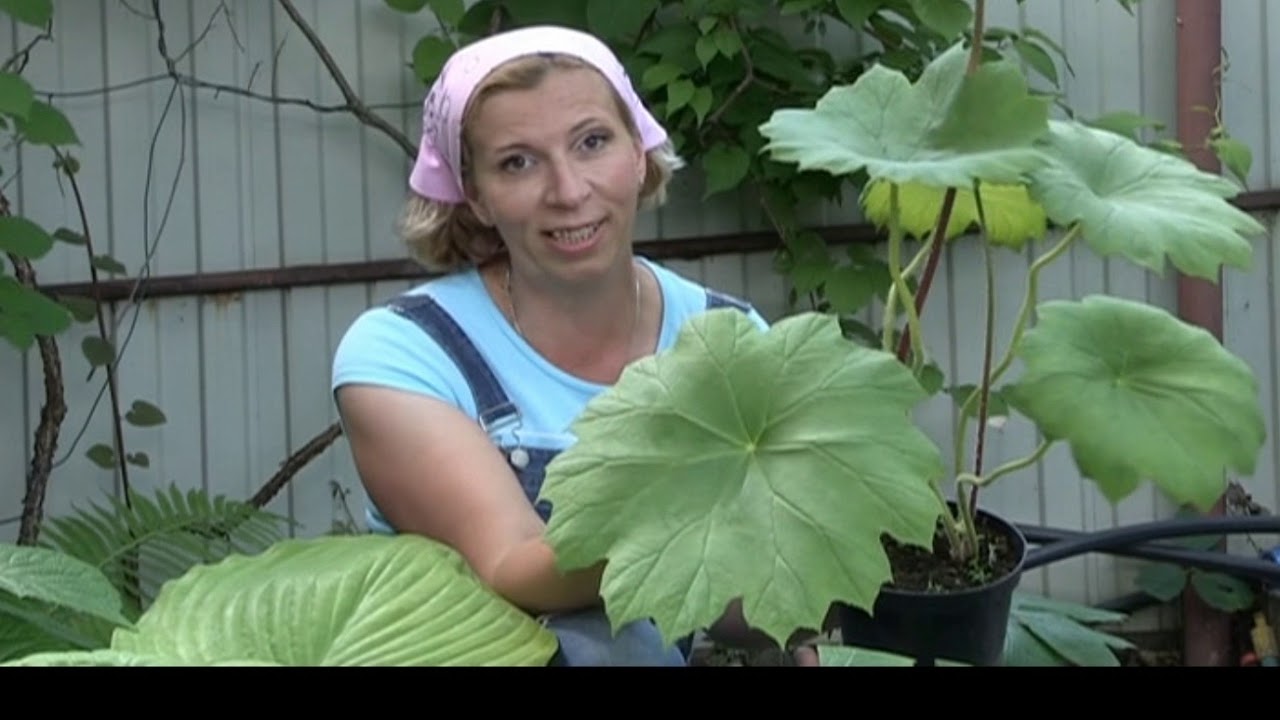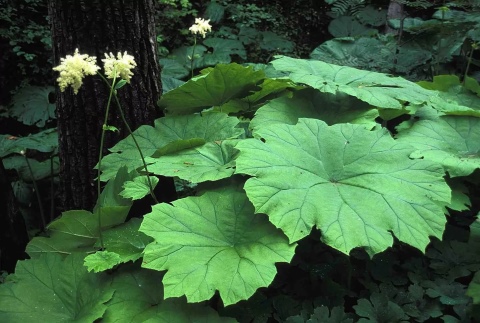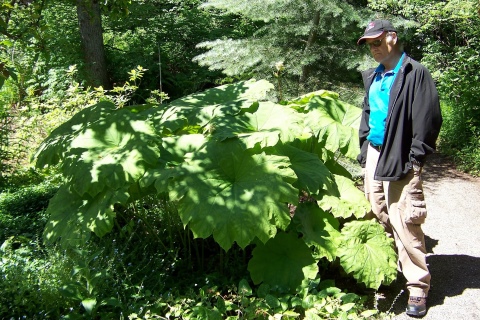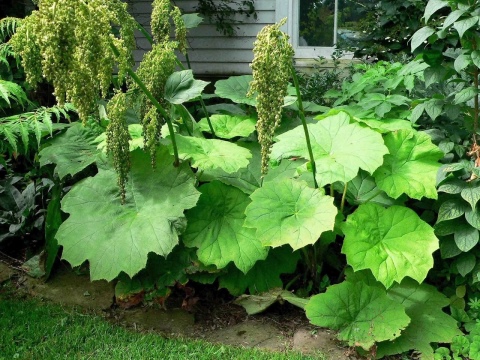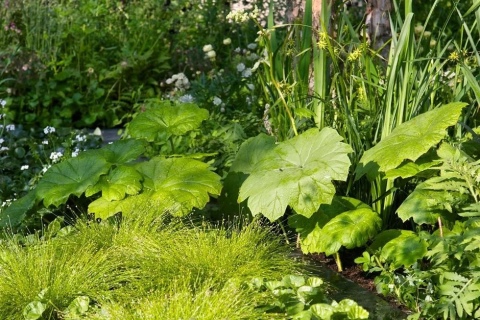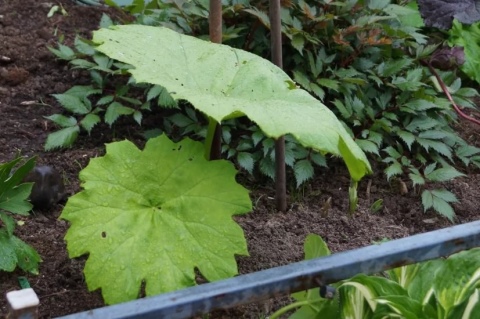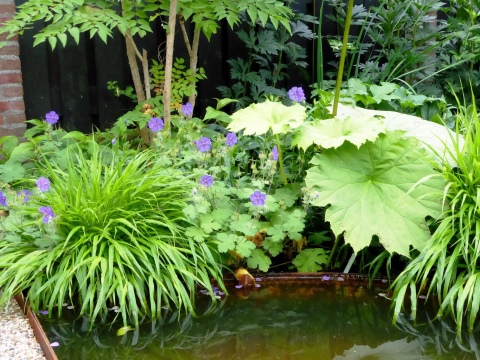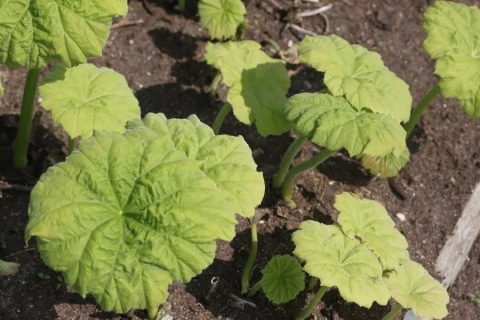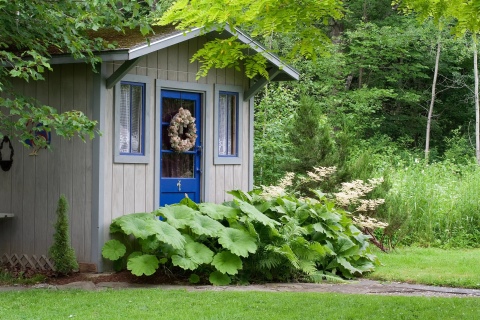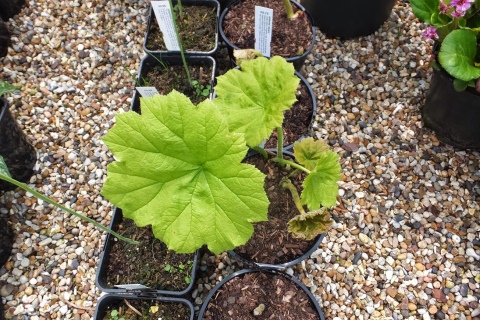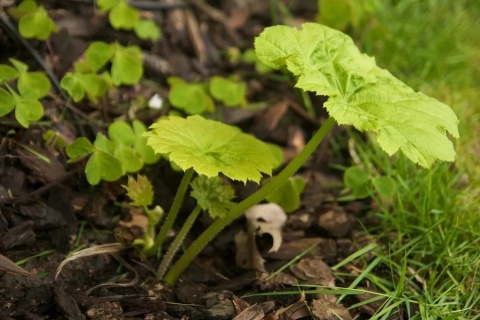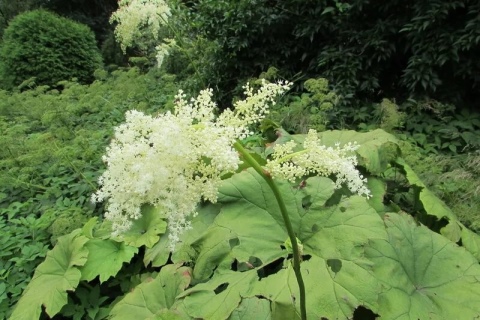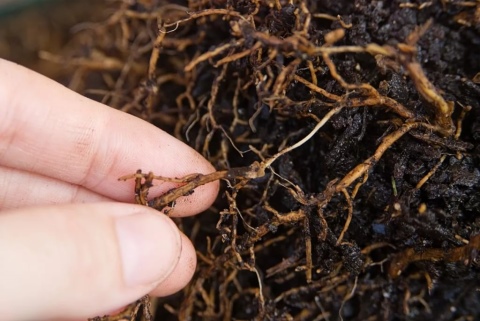Astilboides - care:
Lighting:
Astilboides grows normally and develops in partial shade. Not very fond of direct sunlight. In cases of growing a plant in highly illuminated areas of the earth, the leaves can be hit by strong rays and burned. Therefore, it is better to choose a shady place to grow. This flower is very valuable, because not many plants like to grow in partial shade.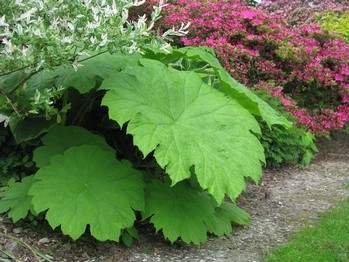
Temperature:
Astilboides prefers medium air temperatures. Will feel great when the air temperature is around 18 - 22 ° C. Can tolerate light frost. In the spring, if there is a strong frost, the leaves of Astilboides may freeze a little. No need to shelter for the winter.
Watering:
Astilboides needs abundant watering, but in moderation. Especially in hot dry summers. You can water the flower two to three times a week. With the onset of winter, the frequency of watering can be reduced.
Humidity:
Astilboides is a very moisture-loving plant. It does not need spraying with water. The optimum air humidity is considered to be 60 - 65%.
Top dressing:
Astilboides responds well to feeding with nutrients. In the summer, several times a month, organic matter, compost, humus can be added to the growth of a flower. Mineral complex fertilizers will also not harm the flower. Astilboides reacts positively to them and will grow healthy and beautiful.
Transfer:
Astilboides does not need frequent transplants, it grows in one place for a long period of time. The flower is transplanted only as needed. If the place for growth is not suitable or the soil is not the right one. Prefers loamy soil with a humus composition.
Reproduction:
Astilboides reproduces by dividing the root, seeds. You can propagate the plant in early spring. Before planting a flower, you need to fertilize the soil with organic substances in order for rooting to occur faster. There should be a bud on a part of the root. When planting, you need to keep the distance between the plants. After disembarking Astilboides, you need to provide him with abundant watering. The plant is mainly propagated by seeds in the middle of spring, when the soil has warmed up enough. Before sowing seeds, you need to stratify them. Sowing must be covered with foil or glass. Then the seedlings dive, they develop very slowly. When they grow up, you can plant them in open ground. If you choose to propagate Astilboides by seeds, then it will bloom only after a few years.
Some features:
Astilboides are grown for garden decoration, in the open field. The flower looks very beautiful if you plant it near a stream, water, along with other moisture-loving plants. It grows slowly, old leaves and flowers must be removed.
Description
It spreads on forest edges and in ravines. The family of Astilboides is saxifrage. Gardeners have learned to grow it in gardens. The plant adds beauty to the site. The species differs depending on the planting (it can be group and single).
The only type of this plant is the lamellar astilboides. It is a perennial shrub that spreads powerful roots underground. The stem is straight and with villi.

The height of the astilboides can be 1.5 meters. The leaves are large and grow on tall stems. Their shade is light green. Rounded plates with a small pattern on the edge.
Astilboides flowers are small in size and white in color. They have no smell. The plant blooms for only one month at the end of summer, sometimes at the beginning of autumn. The duration of this process is one month. In September, seeds remain in the flowers. They are used for culture propagation.
Landing astilboides
Seeds are sifted at the beginning of the winter period. The process is needed for the plant to get used to natural conditions.
It is possible to plant in the spring, but for this, the seeds should be kept in cold conditions (in the refrigerator) a month before planting.
Seeds are sown in a box, which is dug into a plot of land in the garden for the winter. In the spring, it is transferred to a room with warmth and covered with glass (film) for a greenhouse effect.
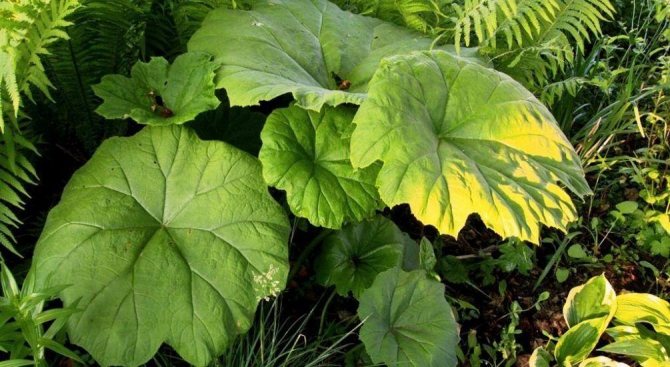
Air temperature suitable for seed germination is 18-25 degrees. It is required to constantly ventilate the box (remove the top cover) and water the soil.
The first shoots appear in mid-May. They must be transplanted immediately into open soil. The plant easily tolerates this process.
But growth will be slowed down. After about four years, astilboides will bloom for the first time and give a beautiful appearance.
Growing astilboides
The plant needs to get used to natural conditions. Therefore, it is worth taking care of this before boarding. Astilboides loves moisture and dark places.
The site must be chosen in places where there is no direct sunlight. It is usually planted between trees, where there is shade.
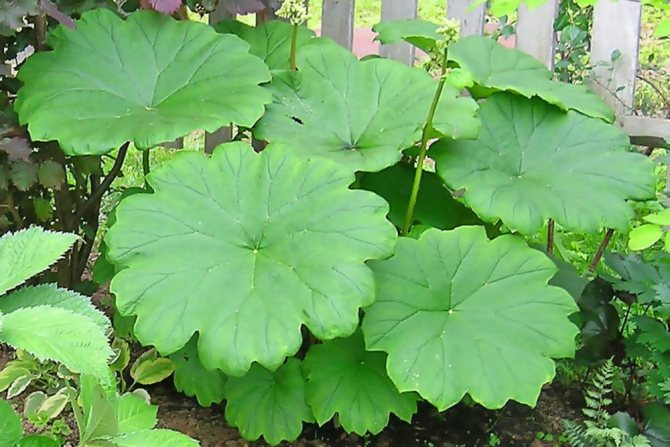
Scattered light will penetrate through the tree branches, this is enough for astilboides. Fertile soil for her is light, fertile and with good air permeability.
Land for planting is prepared in advance. The flower behaves unpretentious in relation to the soil, but still loves fertile soil saturated with vitamins.
A mixture is added to the well, in which they mix:
- Humus;
- Peat;
- Sand;
- Loam.
Mixing ratio: all one at a time, except for loam, two portions. A solution of minerals (in the form of granules) and substrates is added to the ground.
Astilboides loves moisture, and so that it does not evaporate from the soil, the hole is sprinkled with sawdust. During the period of flower growth, the edges of the site are treated from weeds and other seedlings.
When the plant is planted, the hole is covered, pressed lightly and a layer of peat and water in a small amount is applied on top. It takes about a month for the plant to start growing.
Astilboides lamellar landing
If the soil dries out even for a while, flowering, as a rule, does not occur, besides, the plant grows more slowly. Secondly, since astilboides is a forest plant, it grows best in partial shade or even in the shade. However, I noticed that it develops no worse in the sun, but only if the soil under it remains wet. As for the soil, our giant grows well on any garden soil, but nutritious loams are optimal for it. It responds well to the application of a solution of organic fertilizers under the root. Astilboides lamellar spends the winter period without problems, I cover it only in especially cold winters. And very, very rarely, the edges of the first leaves freeze slightly during recurrent spring frosts.
Examples in landscape design
Due to its usual appearance, unpretentiousness and large size, Astilboides is widely used in landscape design. The flower can be either an independent plant or a part of flower arrangements. This plant can be a good background for most flowers with contrasting color of leaves, as well as bright and saturated colors. Bushes of barberry, viburnum, wild rose, mountain ash and bubblegum, as well as forest anemone, geranium and zelenchuk look spectacular near astilboides.
In many projects for decorating reservoirs, experts prefer this particular flower, the huge leaves of which look very beautiful against the background of stones of various shapes, and the high humidity of the territory creates the most favorable conditions for its growth and development. The combination of a flower and sedge will create the effect of untouched wilderness.
Single bushes will be able to decorate the shaded area near the house and outbuildings, as well as along long fences.If you plant a plant in large pots, then you can change the decor of the site, depending on the wishes of the owners.
A beautiful and well-groomed garden plot is the pride of every owner. Each gardener tries to plant the most beautiful plants on his territory that will delight you throughout the year. The presence of buildings and outbuildings does not always make it possible to rationally use every corner
It is in this case that experts recommend paying attention to unpretentious plants that feel great in the shade.
Before purchasing this plant, you must carefully study its characteristics, planting features and the subtleties of care.
In the next video, you will get acquainted with the rules of growing astilboides and outdoor care.
Care rules
Watering
Water the plant in different ways, depending on its location. If astilboides grows in the area of trees, then watering is rarely carried out.
She will have enough moisture from the rains. The summer period is dry, without rain. In this case, you need to monitor the soil under the bush. If it is dry, then the flower needs liquid.
When astilboides lacks water, its leaves take on a brownish tint. Subsequently, she will die. The opposite effect: the plant does not like too much water, from this its roots begin to rot. Water the flower in moderation and only if necessary.
It is not worth changing the plot for an "adult" germinated plant. Astilboides suffers this process painfully, sometimes dies from it.
At the first planting, it is worth taking care of the site and making the soil fertile so as not to transplant the bush in the future.
Gardeners have experience with this procedure in order to rejuvenate. But they do it carefully and only in the spring or autumn.
- The plant is dug out without damaging the roots.
- The root system is carefully cleared of the earth.
- Remove areas that are extinct or unsuitable for further development.
- Astilboides are divided into several pieces.
- The resulting flower parts are planted.
- The beds are sprinkled with fertilizer (peat or sawdust) and watered on top with a small amount of water.
- The adaptation of the plant is observed for three days.
- Carefully take care of the bushes during this period.
The process gives the flower a rejuvenating effect. The division into parts of astilboides allows shrubs to develop and grow further.
You always need to feed the plant. The first addition to the soil is carried out during the planting period, in the form of granules with minerals.
Top dressing
Throughout the life of the shrub, the contents from the compost pit are brought under it. The frequency of adding compost feed every month.
A pruning process is required to keep the crop looking neat. Remove leaves that have dried up and flowers that have faded.
Reproduction
In the latter case, removal occurs if there is no need to propagate the plant.
Reproduction can be done not only by seeds, but also by bushes. This process is best done in early May. During this period, young leaves appear.
There is no point in digging up the plant completely. To divide the astilboides, cut off the shoot that has the starting point of its growth. It makes it possible for the shrub to grow further after planting.
The shoot is separated with a sharpened knife. The process requires care and accuracy, otherwise the mother shrub can be damaged.
The separated shoot is planted in a new place, fertilized and moistened. As soon as the new Astilboides bloom after transplanting in the first year of life, the flowers are removed.
This contributes to directing forces towards adaptation and growth.
In the fall, astilboides leaves dry out. Roots remain in the soil, which give new shoots after winter.
If the winter period is snowy and warm, then you should not worry and shelter the plant from frost. If there is little snow in winter and it is cold, then the area with the rhizome is covered with foliage or spruce branches.
In the spring, the shelter is removed.
Plant diseases
Astilboides is resistant to various diseases. But due to the property of growing in the shade, it can be eaten by snails, which damage the leaves of the plant.
You can't get rid of them forever. To do this, the bush is monitored and pests are collected manually, or they are treated with drugs once a season. A proven and effective remedy - "Thunderstorm".
Problems can appear due to improper plant care. From these problems, the leaves of Astilboides dry up, and its development in growth slows down.
An excess of light and a lack of moisture can lead to the death of the bush. With the timely elimination of problems, astilboides will quickly return to its original shape.
Description
Astilboides tabularis (astilboides tabularis) is an unusual plant that grows naturally in shady and humid forests, near water bodies, as well as in ravines and on slopes. The homeland of this flower is China, Korea and Manchuria.
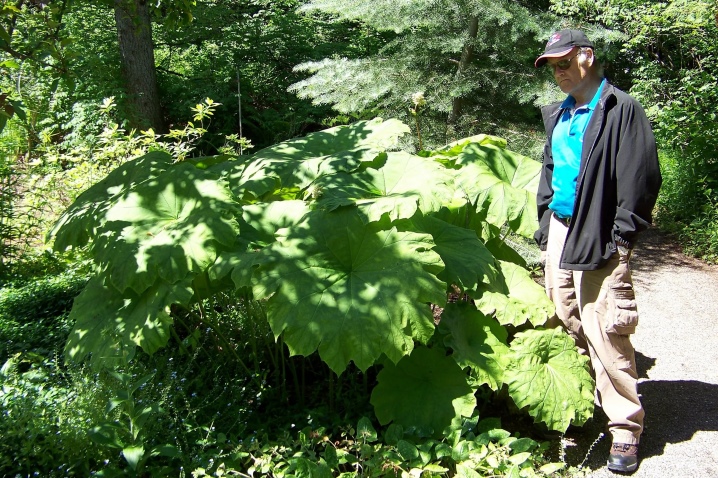
Initially, the flower belonged to the Saxifrage family, but after a while this plant was assigned to the genus of the same name Astilboides, in which it is the only representative.
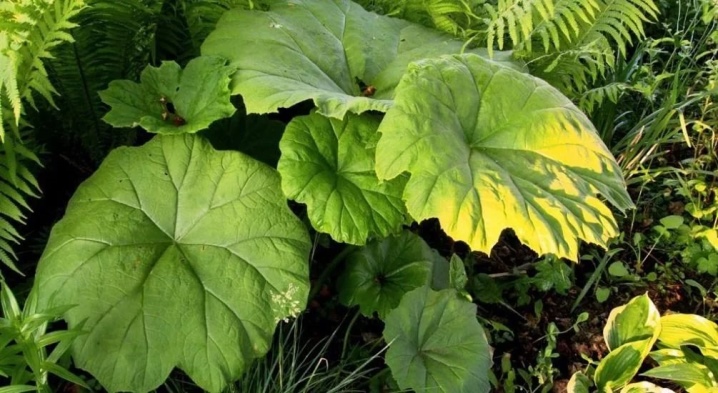
Astilboides is a herbaceous perennial plant that is impressive in size and intended for outdoor cultivation. The maximum leaf size in an adult plant can reach 150 cm, and the height of the stems exceeds 120 cm.
The leaf plate is painted in a bright green hue, against the background of which lighter veins look especially impressive.
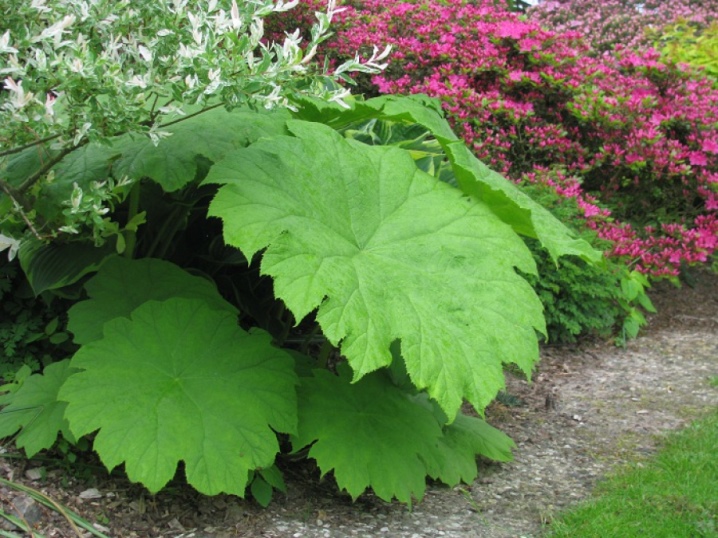
The bell-shaped flowers are collected in very large inflorescences, the height of which can reach 170 cm. The flowering period is mid-summer. The plant will delight its owners with flowers for a whole month.
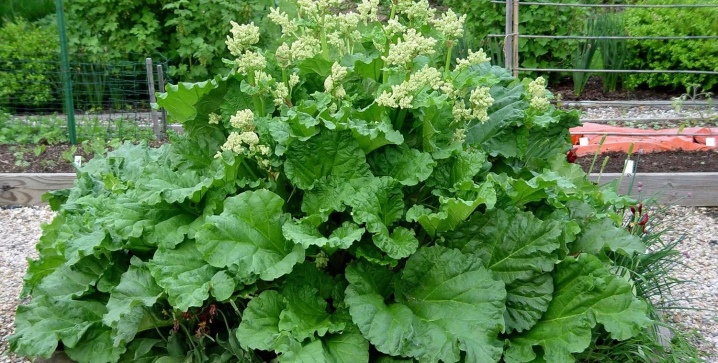
Despite the beauty of the inflorescences, they practically do not emit a scent. After the flowers wither, seeds appear in their place, which can subsequently be effectively used for propagation. The length of the superficial root system reaches 35 cm, and the thickness of the roots is 30 mm.
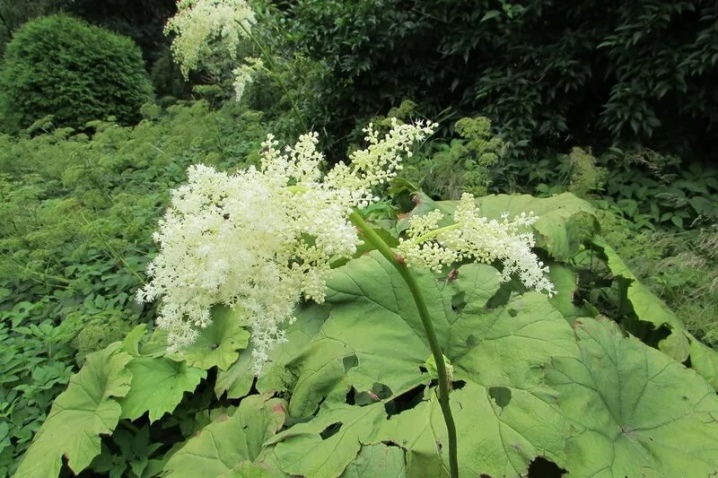
Astilboides
The homeland of astilboides is China, where it grows along forest edges, ravines.

Astilboides lamellar - perennial, 30 cm tall with hard leaves 70 cm in diameter, on long petioles.

The flowers are creamy, small, they are collected in a paniculate inflorescence, drooping towards the end of flowering. Astilboides peduncle 1.5 m in height. The plant blooms in July. The rhizome is thick, superficial.


Location for astilboides
The best place for planting partial shade, Astilboides prefers rich loam.
Moisture-loving plant. Astilboides lamellar winters well without shelter; young foliage freezes from late spring frosts.


In conditions with good moisture, the plant can tolerate bright sunlight, but astilboides is still a shade plant.

Astilboides care
Demanding on soil moisture. During the season, it is necessary to feed with organic fertilizers several times. Astilboides does not need transplants for many years. It grows slowly. Old foliage and flower stalks need to be cut off.

By dividing the rhizomes. Astilboides are best propagated in the spring.
In culture: since 1888.

Use of astilboides
As a solitary planting, the plant is spectacular when planted near water.
Astilboides partners: goes well with yellow iris and barberry.

Liatris
Liatris got its name from the Greek words: "laios" means "smooth", and "iatros" - "doctor". Description of Liatrix There are more than 20 species of vroda growing in North America. Perennial rhizome herb with branched or simple ...
Ayuga (Zhivuchka)
Tenacious or Ayuga - Ajuga L Family: lip-colored (Lamiaceae). Homeland: Europe, Caucasus Blossoming: June. Growth: height 15-20 cm. Lighting Ayuga In bright shady or semi-shady places, if there is enough moisture, in sunny or cool places. The soil for ...
Lungwort
The name of the lungwort comes from the Latin word ‘pulmo’ in translation light.In ancient times, lungwort leaves were used in the treatment of lung diseases. Rod contains about 15 species. All lungwort grow on the Eurasian continent and ...
Hellebore
The hellebore flower has a large calyx, and its petals resemble thick small funnels and are intended for the secretion of nectar. The plant also has a bunch of stamens and about a dozen pistils. The flowering process goes unnoticed ...
Hosta
Hosta or its other name function is considered the "queen" of the shady garden. The bright and very decorative hosta has luxurious rosettes formed by dense basal leaves. Hosta flowers amaze with their variety of shapes, colors and textures in ...

